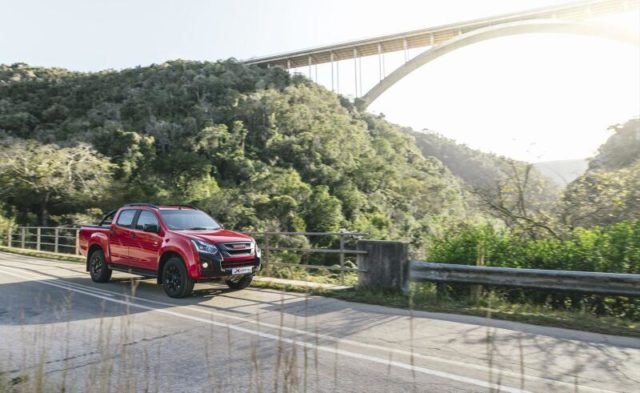If you’re considering a Raider or FX4, you might want to also consider taking the X-Rider for a spin.
JOHANNESBURG – One can argue that Isuzu’s X-Rider nomenclature is as identifiable in South Africa and as popular as Ford’s Wildtrak/FX4 stickers or Toyota’s Raider badging when it comes to bakkies.
The X-Rider nameplate has quickly established itself as a popular model within the Isuzu D-Max line-up, initially only offered with the 2.5-litre high-output diesel engine. Last year amid lockdown, however, Isuzu unveiled the 3.0-litre version, bringing more power and grace (with a relative sense of affordability) to the venerable D-Max line-up.
“The X-Rider nameplate, which was first introduced in South Africa as a limited edition model in 2016, has been a great success for us,” says Dominic Rimmer, the executive, Technical Services at Isuzu Motors South Africa (IMSA).
“Until now, we have only offered the X-Rider as a mid-range vehicle available with the 100kW 2.5-litre engine.
“Based on the popularity of the X-Rider, we felt it would make sense to match this nameplate with our most powerful engine, while retaining the attributes which make the X-Rider so popular. The 3.0 X-Rider has an imposing presence on the road with a rugged and sporty look which sets it apart from regular D-Max models.”
The 3.0 X-Rider Automatic is powered by the company’s familiar four-cylinder 130kW turbodiesel engine that does duty in the LX range-topper and AT35. It’s mated to a robust six-speed automatic gearbox that can be shifted manually through a tiptronic shifter. On the road, the bakkie pulls like a beast, all the way to its redline before grabbing another gear without breaking a sweat.
It has a really meaty feel to it, more like a V6 than a four-cylinder. It’s nicer than Ford’s single-turbo job and I prefer it to the Ford BiTDI in terms of torque feel, despite its agricultural nature.
The engine’s maximum power output is reached at 3 600rpm, with max torque of 380Nm available between 1 800 and 2 800rpm. Thanks to its low torque, and the slick shifting automatic transmission, it hustled about on the test drive with ease. I was comfortably able to overtake on the highway without feeling like the vehicle was labouring. Compared to the 100kW version, this 130kW version will be the better choice if you tow, or if you carry adventure quad bikes to far-flung places on the weekends.
The latest 3.0 TD X-Rider comes standard with a black roof rails, black sports bar with Red X-Rider logo, black running boards, 20cm AX2 radio with multifunction colour touch screen, black tailgate handle with rear view camera, and a 3.5 ton towbar.
The seats are covered in black partial leather with red stitching and it’s only available in three colours: Summit White, Switchblade Silver, and Pull Me Over Red. I’d have the red based on availability, as it’s arguably the fastest (looking), and also because it matches our Ford Ranger FX4 long-termer.
Jokes aside, the interior and the specification appointments in the latest X-Rider make it a fantastic place to be. Sure, it’s a little bit dated inside in terms of look and feel compared to the latest Rangers and Hiluxes, but it’s solid inside and out, built with good quality materials that feel durable. The plastics on the inside, for example, look very 2010s, but you can rest assured these bits and pieces will stand the test of time, like the D-Max itself, notably.
The vehicle rides on standard 18-inch diamond-cut alloy wheels wrapped in all-terrain tyres, while the same size all-black alloy wheels are available as a no-cost option. On the tarmac, where I spent most of my time, the wheel and tyre combo worked in harmony with the bakkie, providing ample grip, feel and confidence.
The D-Max’s suspension is arguably one of the best in the business, perhaps the sharpest handling if that’s your thing in bakkies. It not only soaked up imperfections well, it also had very little flex, rattles or tremors when I negotiated washboard-surface tarmac out towards the Cradle of Humankind. It’s not going to win any awards for Grand Touring ability, but as far pick-up trucks go, it’s a decent package that will only get better in the next generation D-Max, which arrives later this year.
Priced at R578,700, the Isuzu D-Max 3.0 TD Double Cab X-Rider Auto undercuts the Toyota Hilux 2.8GD-6 double cab Raider auto (R644,500) and Ford Ranger 2.0SiT double cab Hi-Rider XLT FX4 (R634,200) by a substantial amount.
Yes, the Toyota and the Ford are fresher, come with nicer technologies inside and offer more street appeal, but I reckon you won’t make a bad choice if you go with the Isuzu in this segment – if a no-nonsense lifestyle accessory is what you’re after.
At the top of the bakkie pile, I’d have the Ranger Raptor (because of its amazing suspension system), but that car costs more than R900,000 new. As much as I love it, I can’t justify that price for a bakkie of any kind (unless it’s electric).
It’s this median level, the in-betweeners if you will, such as the X-Rider (the FX4 and the Raider) that represent the best of what bakkies have to offer in South Africa right now, if you would like to remain frugal with your spending in these challenging economic times.
All D-Max models come with Isuzu Complete Care, which combines a 5-year/120,000km bumper-to-bumper warranty, with regular, scheduled maintenance and Roadside Assistance for peace of mind, wherever you are.
I’d recommend you take the 3.0-litre X-Rider for a test drive before deciding which bakkie to buy. It’s a fantastic package that comes at the right price for our time, considering the rising cost of pretty much everything around us. I’d get it in Midnight Black (sadly, it’s not available in that colour), and I’d chuck on some spotlights on that roof bar and, for many years to come, I’d be happy with my purchase because of its old-school charm.
IOL MOTORING








